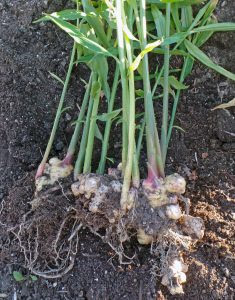Every year since 1995, the International Herb Association has chosen an Herb of the Year™ to showcase. This year’s selection is Ginger, or Zingiber officinale, which you’ll find in the culinary bed of the CPOR Herb Garden. An IHA committee makes its selection based on the plant meeting two of three criteria: medicinal, culinary or decorative use. Edible or culinary ginger is the knobby, aromatic rhizome of Zingiber officinale, a perennial plant. It was introduced to northern Europe by the Romans, from Arab traders, and has remained a favorite seasoning used in many different cuisines over the centuries. In addition to its culinary value, ginger is used medicinally to treat numerous ailments.
 Ginger is grown commercially in Southeast Asia, tropical Africa, parts of Central America and the Caribbean, and Australia. It takes about 8-10 months from planting to harvest the crop. Ginger is hardy in USDA Zones 8-12 but can be grown in containers and moved indoors for the winter in colder climates where the season is too short for the rhizomes to mature. Plant ginger in the garden as a seasonal plant for “baby ginger” or “green ginger,” and harvest after about four months while still immature. Starting it in a container in early spring will enhance yield. Ginger grows well in rich organic matter with regular watering, but avoid over-watering and soggy soil. As an understory plant in the tropics, ginger prefers partial shade. Here in the Midwest, plants moved indoors for the winter will go dormant and lose all their stems with the onset of short winter days and cool temperatures. The rhizomes can be stored over the winter in a container of soil, or can be dug up, cleaned and stored in a brown paper bag in a cool, dry place. Rhizomes for replanting should not be refrigerated. In early spring, move the bare or planted rhizomes to a warm, bright spot, and new shoots should begin to sprout. Replant bare rhizomes, and resume watering at that point. Plants grown this way can be replanted and dug up to harvest all or a portion of the rhizomes every year or two.
Ginger is grown commercially in Southeast Asia, tropical Africa, parts of Central America and the Caribbean, and Australia. It takes about 8-10 months from planting to harvest the crop. Ginger is hardy in USDA Zones 8-12 but can be grown in containers and moved indoors for the winter in colder climates where the season is too short for the rhizomes to mature. Plant ginger in the garden as a seasonal plant for “baby ginger” or “green ginger,” and harvest after about four months while still immature. Starting it in a container in early spring will enhance yield. Ginger grows well in rich organic matter with regular watering, but avoid over-watering and soggy soil. As an understory plant in the tropics, ginger prefers partial shade. Here in the Midwest, plants moved indoors for the winter will go dormant and lose all their stems with the onset of short winter days and cool temperatures. The rhizomes can be stored over the winter in a container of soil, or can be dug up, cleaned and stored in a brown paper bag in a cool, dry place. Rhizomes for replanting should not be refrigerated. In early spring, move the bare or planted rhizomes to a warm, bright spot, and new shoots should begin to sprout. Replant bare rhizomes, and resume watering at that point. Plants grown this way can be replanted and dug up to harvest all or a portion of the rhizomes every year or two.
